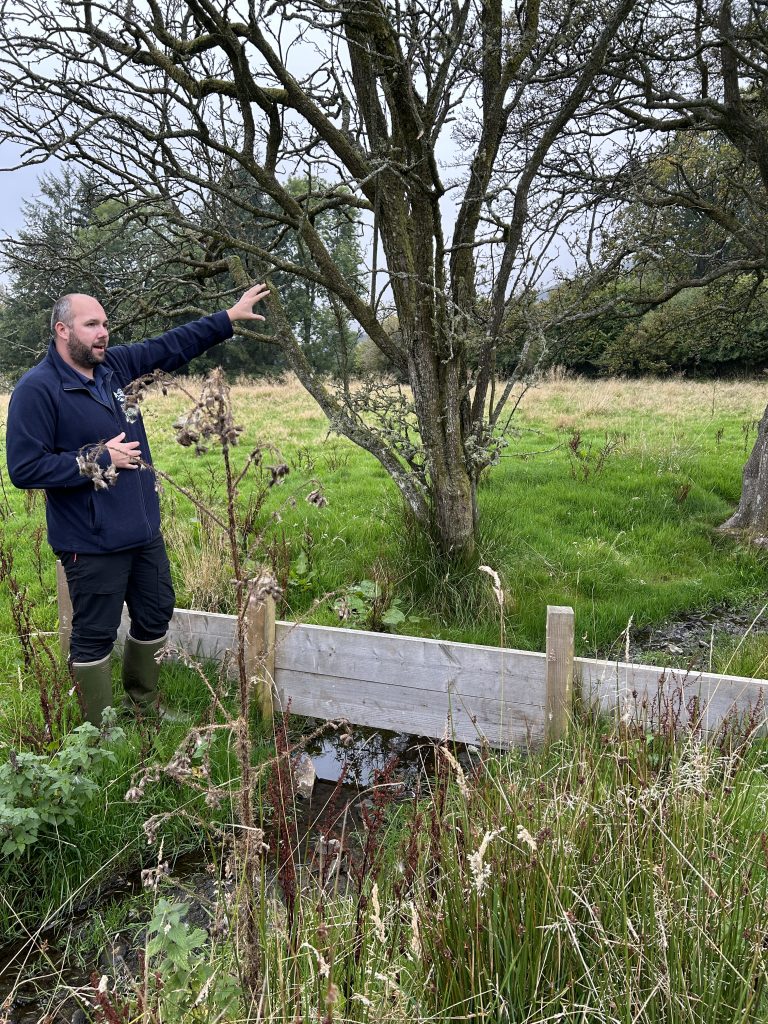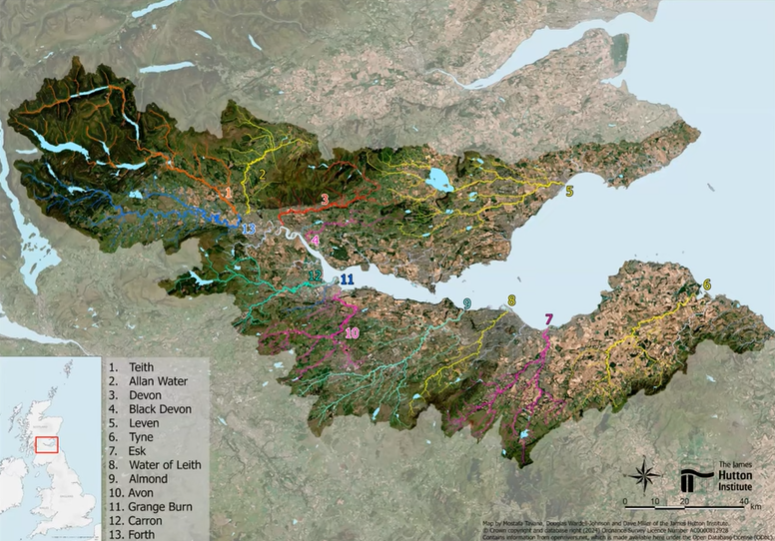Lunchtime Learning: Flooding Resilience

Flooding Resilience: Lunchtime Learning
As part of our adaptation skills themed webinar series, this session spotlighted community-led approaches to managing flood risk through nature-based solutions and education.
Speakers and Key Insights:
The session brought together expert insights from Charlotte Neary of Forth Rivers Trust and Clare Johnstone from The Conservation Volunteers (TCV), who shared inspiring examples of collaborative projects that build local resilience while boosting biodiversity.
Charlotte presented a map of the Forth Catchment Area created by The James Hutton Institute.

Charlotte highlighted the Pools of Muckhart project, a community-driven initiative tackling flooding in Clackmannanshire. Through a series of natural interventions; scrapes, willow leaky dams, and marshy grasslands, the project demonstrated how low tech, nature based solutions can redirect high flows, reduce downstream flood risk, and simultaneously create thriving wetland habitats. The project was codesigned with local residents and supported by multiple stakeholders including the Church of Scotland, Clackmannanshire Council, the Woodland Trust and TCV.
Complementing this, the Allanwater project focused on restoring peatlands, replanting riparian woodland, reconnecting rivers to floodplains, and installing woody debris to mimic natural river processes. These interventions not only slow peak flows and prevent downstream flooding, but also improve habitat for species like otters, salmon, and amphibians.
FV Climate Hub visited for a learning visit during Climate Week 2024, you can read the blog and see a few photos here: Climate Week events and stories – FEL Scotland
Clare from TCV emphasised that community ownership is key to long term flood resilience. Working in towns across Clackmannanshire and the wider Forth catchment, TCV empowers local people, from school pupils to older residents to take part in tree planting, wildflower meadow creation, and the removal of invasive species like Himalayan Balsam. These activities not only build local biodiversity but also enhance physical and mental wellbeing.
Clare’s work includes educational sessions in schools to help children understand the science of river systems and how to respond to flooding, such as by preparing “grab bags” in case of evacuation. Through practical conservation skills like willow spiling and citizen science, communities are gaining the tools and confidence to manage local green spaces more sustainably.
“EPIC Volunteers take on practical conservation activities across Clackmannanshire. We help look after our path network, make our greenspaces better for wildlife through biodiversity improvements and support community groups in the Wee County”
Glossary: Flooding Resilience Terms
Living Willow Leaky Dams
Structures made by weaving live willow branches and stakes across small water channels. They slow water during high flows and grow over time, becoming self-reinforcing and enhancing biodiversity.
Leaky Dam
A simple structure (often logs or branches) placed across a stream or ditch to slow water flow without fully blocking it. They help reduce peak flood levels and mimic natural fallen trees.
Spiling
A traditional riverbank reinforcement technique using woven live willow to stabilise eroding banks. It’s both practical and environmentally beneficial.
Scrapes
Shallow, seasonal ponds or depressions designed to temporarily hold water during heavy rainfall. Scrapes reduce flood peaks and create valuable wetland habitat for wildlife.
Deflector Channels
Man-made shallow diversions designed to steer water away from vulnerable areas (like homes or roads) during floods. Often used in conjunction with scrapes and wetlands.
Wetland Restoration
The process of re-establishing wetlands to slow runoff, store water, reduce downstream flooding, and provide rich wildlife habitats.
Peatland Restoration
The rewetting of drained peatlands to reduce carbon emissions, boost biodiversity, and act as “sponges” that hold and slowly release water, reducing flood risk downstream.
Riparian Tree Planting
Planting native trees along riverbanks to slow runoff, cool river temperatures, stabilise banks, and increase biodiversity. Trees must be protected from grazing (e.g. deer, beavers).
Tree Protection Methods
- Biodegradable Polymers: Eco-friendly guards that break down over time.
- Organic Sheep’s Wool: Repels deer due to scent; used as a natural deterrent.
- Mycorrhizal Pellets: Introduced at planting to encourage underground fungal networks that support tree health and resilience.
We’re planning more Flooding Resilience events and potential forums for 2025, if you are interested in attending or getting involved please email Climate@FELScotland.org
